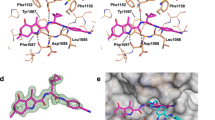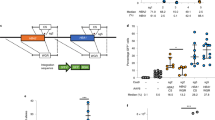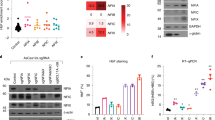Abstract
Sickle cell disease is caused by a mutation in the β globin gene leading to hemoglobin S (Hb S) production. Several approaches have been explored to prevent Hb S polymerization in red blood cells and the symptoms associated with this disorder. To this end we tested a mammalian expression vector carrying a human β globin antisense cDNA (pZeoβAS) fragment in a mouse erythroleukemia cell line expressing the human γ and β globin genes. We observed a relative reduction in β globin mRNA levels compared with γ mRNA levels in the presence of pZeoβAS. Moreover, analysis at the protein level showed an average 76% decrease in β chains and a 517% increase in γ chain biosynthesis. The inhibitory effect of the antisense vector on globin expression was maintained long term in culture. The expression vector pZeoβAS was also transfected into primary erythroid progenitors to test its effects on globin genes undergoing normal developmental switching during differentiation. We observed a relative reduction of β globin mRNA levels compared with γ mRNA levels. These results support a novel role for antisense cDNA expression vectors as an alternative gene therapy strategy to inhibit βs gene expression in sickle cell disease.
This is a preview of subscription content, access via your institution
Access options
Subscribe to this journal
Receive 12 print issues and online access
$259.00 per year
only $21.58 per issue
Buy this article
- Purchase on Springer Link
- Instant access to full article PDF
Prices may be subject to local taxes which are calculated during checkout





Similar content being viewed by others
References
Stamatoyannopoulos G, Nienhuis AW . Hemoglobin Switching. In: Stamatoyannopoulos G, Neinhuis AW, Majerus V (eds) Molecular Basis of Blood Diseases WB Sanders: Philadelphia 1994 pp 107–155
Cao SX, Gutman PD, Dave HP, Schechter AN . Identification of a transcriptional silencer in the 5′-flanking region of the epsilon-globin gene Proc Natl Acad Sci USA 1989 86: 5306–5309
Raich N, Papayannopoulou T, Stamatoyannopoulos G, Enver T . Demonstration of a human epsilon-globin gene silencer with studies in transgenic mice Blood 1992 79: 861–864
Behringer RR et al. Human gamma- to beta-globin gene switching in transgenic mice Genes Dev 1990 4: 380–439
Enver T et al. Developmental regulation of human fetal-to-adult globin gene switching in transgenic mice Nature 1990 344: 309–313
Hanscombe OD et al. Importance of globin gene order for correct developmental expression Genes Dev 1991 5: 1387–1394
Stamatoyannopoulos G . Human hemoglobin switching Science 1991 252: 383
Perrine SP et al. Butyrate infusions in the ovine fetus delay the biologic clock for globin gene switching Proc Natl Acad Sci USA 1988 85: 8540–8542
Pace B, Li Q, Peterson K, Stamatoyannopoulos G . α-Amino butyric acid cannot reactivate the silenced gamma gene of the beta locus YAC transgenic mouse Blood 1994 84: 4344–4353
Rachmilewitz EA, Aker A . The role of recombinant human erythropoietin in the treatment of thalassemia Ann NY Acad Sci 1998 850: 129–138
Zitnik G, Peterson K, Stamatoyannopoulos G, Papayannopoulou T . Effects of butyrate and glucocorticoids on gamma- to beta-globin gene switching in somatic cell hybrids Mol Cell Biol 1995 15: 790–795
Fucharoen S et al. Hydroxyurea increases hemoglobin F levels and improves the effectiveness of erythropoiesis in beta-thalassemia/hemoglobin E disease Blood 1996 87: 887–892
Charache S et al. Effect of hydroxyurea on the frequency of painful crises in sickle cell anemia New Engl J Med 1995 332: 1317–1322
Padanilam BJ, Huisman TH . The beta zero-thalassemia in an American black family is due to a single nucleotide substitution in the acceptor splice junction of the second intervening sequence Am J Hematol 1986 22: 259–263
Gonzalez-Redondo JM et al. A C–T substitution at nt-101 in a conserved DNA sequence of the promoter of the beta gene is associated with ‘silent’ beta-thalassemia Blood 1989 73: 1705–1711
Gonzalez-Redondo JM et al. Severe Hb S-beta zero-thalassemia with a T–C substitution in the donor splice of the first intron of the beta-globin gene Br J Haematol 1989 71: 113–117
Chang JC, Kan YW . Betao thalassemia, a nonsense mutation in man Proc Natl Acad Sci USA 1979 76: 2886–2889
Kazazian HH Jr et al. Characterization of a spontaneous mutation to a beta-thalassemia allele Am J Hum Genet 1986 38: 860–867
Kazazian HH Jr et al. Molecular characteristic of seven beta-thalassemia mutations in Asian Indians EMBO J 1984 3: 593–596
Xu L, Pace BS . Modulated human globin gene expression: role for antisense expression vectors Cell Mol Biol Letters 1998 3: 423–433
Weinberg RS et al. Stem cell factor amplifies newborn and sickle erythropoiesis in liquid culture Blood 1993 81: 2591–2599
Green PJ, Pines O, Inouye M . The role of antisense RNA in gene regulation Annu Rev Biochem 1986 55: 569–597
Lan N et al. Ribozyme-mediated repair of sickle beta-globin mRNAs in erythrocyte precursors Science 1998 280: 1593–1596
Davidkova G et al. D2 dopamine antisense RNA expression vector, unlike haloperidol, produces long-term inhibition of D2 dopamine-mediated behaviors without causing up-regulation of D2 dopamine receptors J Pharmacol Exp Ther 1998 285: 1187–1196
Ratajczak MZ et al. In vivo treatment of human leukemia in a SCID mouse model with c-myb antisense oligodeoxynucleotides Proc Natl Acad Sci USA 1992 89: 11823–11827
Fibach E et al. Hemin-induced acceleration of hemoglobin production in immature cultured erythroid cells: preferential enhancement of fetal hemoglobin Blood 1995 85: 2967–2974
Donze D, Townes TM, Bieker JJ . Role of erythroid kruppel-like factor in human γ- to β-globin gene switching J Biol Chem 1995 270: 1955–1959
Ferry A, Baliga SB, Monteiro C, Pace BS . γ Globin gene silencing in primary erythroid cultures: an inhibitory role for interleukin-6 J Biol Chem 1997 272: 20030–20037
Acknowledgements
The NIH Grant, HL 38639–09 to the USA Comprehensive Sickle Cell Center and Betty S Pace, MD, supported this work. We thank Dr Gan Wang, Ying Zhao, Jianguo Xu, Wei Luo, Xiaotian Yan and Hao Chen for excellent technical assistance.
Author information
Authors and Affiliations
Rights and permissions
About this article
Cite this article
Xu, L., Ferry, A., Monteiro, C. et al. Beta globin gene inhibition by antisense RNA transcripts. Gene Ther 7, 438–444 (2000). https://doi.org/10.1038/sj.gt.3301106
Received:
Accepted:
Published:
Issue Date:
DOI: https://doi.org/10.1038/sj.gt.3301106



